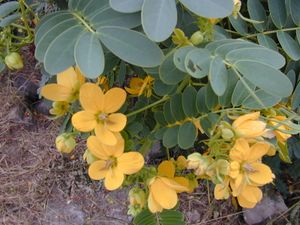Note: This is a project under development. The articles on this wiki are just being initiated and broadly incomplete. You can Help creating new pages.
Senna siamea - Siamese Senna
Siamese Senna is a large genus of flowering plants in the legume family Fabaceae and the subfamily Caesalpinioideae. This diverse genus is native throughout the tropics, with a small number of species in temperate regions.
Uses
hemorrhoids, weight loss, irritable bowel syndrome, abdominal pain, Female Hair Loss, Constipation, Hemorrhoids, Intestinal Worms, Indigestion
Parts Used
Chemical Composition
Dianthrone glycosides (1.5% – 3%), SennosManjakonna, Manjakonneiides A and B (rhein dianthrones containing the aglycone Sennidin A and Sennidin B respectively), Sennosides C and D (gylcosides of heterodianthrones rhein and aloe emodin)[1]
Common names
| Language | Common name |
|---|---|
| Kannada | Sima tangedu, Hiretangedi |
| Hindi | Seemia, Kassod |
| Malayalam | Manjakonna, Manjakonnei |
| Tamil | Manjal konrai |
| Telugu | Sima tangedu, Kurumbi |
| Marathi | NA |
| Gujarathi | NA |
| Punjabi | NA |
| Kashmiri | NA |
| Sanskrit | Swarn Patri |
| English | Siamese Senna, Siamese cassia |
Properties
Reference: Dravya - Substance, Rasa - Taste, Guna - Qualities, Veerya - Potency, Vipaka - Post-digesion effect, Karma - Pharmacological activity, Prabhava - Therepeutics.
Dravya
Rasa
Tikta (Bitter), Kashaya (Astringent)
Guna
Laghu (Light), Ruksha (Dry), Tikshna (Sharp)
Veerya
Ushna (Hot)
Vipaka
Katu (Pungent)
Karma
Kapha, Vata
Prabhava
Habit
Identification
Leaf
| Kind | Shape | Feature |
|---|---|---|
| Simple | The leaves are paripinnately compound, the leaflets opposite |
Flower
| Type | Size | Color and composition | Stamen | More information |
|---|---|---|---|---|
| Unisexual | 2-4cm long | yellow, rarely white | 4 | They are buzz pollinated and offer pollen as a reward to pollinators |
Fruit
| Type | Size | Mass | Appearance | Seeds | More information |
|---|---|---|---|---|---|
| 7–10 mm | The fruit is a legume, indehiscent or tardily dehiscent | many | {{{6}}} |
Other features
List of Ayurvedic medicine in which the herb is used
- Vishatinduka Taila as root juice extract
Where to get the saplings
Mode of Propagation
How to plant/cultivate
The tree will grow in a range of climatic conditions, but is particularly suited to the lowland tropics with a monsoon climate, where it can succeed at elevations up to 1,300 metres[3]
Commonly seen growing in areas
Photo Gallery
Planted at road side. Bogor, West Java
References
External Links
- Ayurvedic Herbs known to be helpful to treat hemorrhoids
- Ayurvedic Herbs known to be helpful to treat weight loss
- Ayurvedic Herbs known to be helpful to treat irritable bowel syndrome
- Ayurvedic Herbs known to be helpful to treat abdominal pain
- Ayurvedic Herbs known to be helpful to treat Female Hair Loss
- Ayurvedic Herbs known to be helpful to treat Constipation
- Ayurvedic Herbs known to be helpful to treat Hemorrhoids
- Ayurvedic Herbs known to be helpful to treat Intestinal Worms
- Ayurvedic Herbs known to be helpful to treat Indigestion
- Herbs with Leaves used in medicine
- Herbs with Fruits used in medicine
- Herbs with common name in Kannada
- Herbs with common name in Hindi
- Herbs with common name in Malayalam
- Herbs with common name in Tamil
- Herbs with common name in Telugu
- Herbs with common name in Sanskrit
- Herbs with common name in English
- Habit - Evergreen Tree
- Index of Plants which can be propagated by Seeds
- Index of Plants which can be propagated by Cuttings
- Herbs that are commonly seen in the region of Trophical region
- Herbs that are commonly seen in the region of Temperate region
- Herbs







